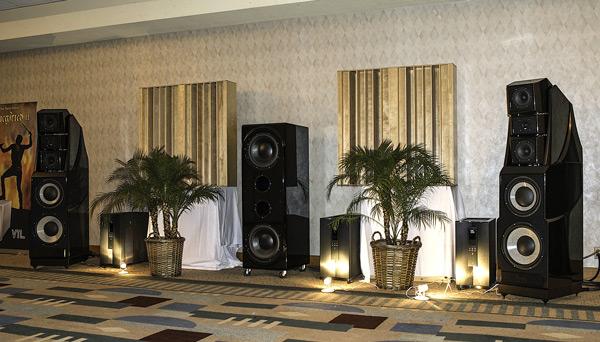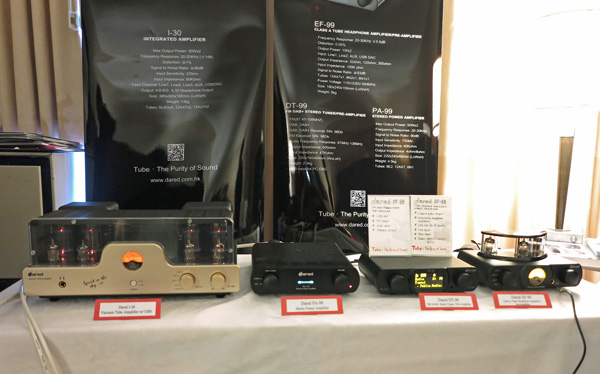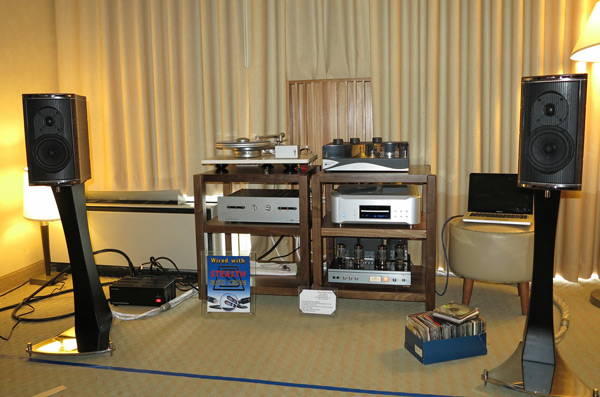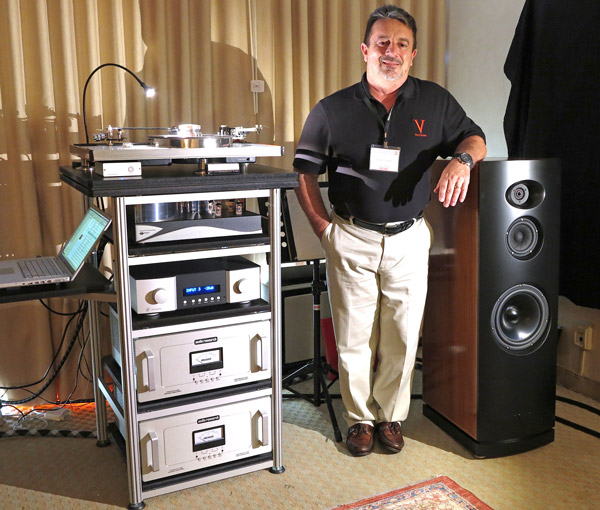| Columns Retired Columns & Blogs |
JVS..you did a great job reviewing this one. And those Wilson's..in a class all by themselves.

This, mind you, was in a near impossible room where ultimate bass control was a nice idea, and the system's open, singing highs were fighting for the lives as they encountered padded walls. That the Alexandria XLFs managed to transcend such limitations is a credit, not only to Dave, but also to recording engineer and Wilson Audio servant (in the best sense of the term) Peter McGrath, who can probably set up Wilson loudspeakers better than anyone on the planet; Bea Lam and Luke Manley of VTL; John Quick of dCS; Joe Wessling and Garth Leerer of Musical Surroundings, the entire team at Music Lovers Audio, and folks whose names I either don't know or spaced out in the thrill of the moment.

I had initially planned to audition the Alexandria XLFs after hours. But when John Kieser, General Manager of the San Francisco Symphony (pictured in front row, seat 3) showed up with Jack Vad, Producer and Recording Engineer; (second row, seat 3) Andrea Luhrs, incoming SFS Media Manager (front row, seat 2), and Andy Eiseman, outgoing Media Manager (second row, seat 1), the time was ripe.
Together with a full house of listeners that included yours truly (gripping his camera and monopod in a futile attempt to stay grounded amidst the rush), Stereophile's Brian Damkroger (second row, end), and, to the far right against the wall, dCS's John Quick and Music Lovers Audio's Jae Wheeler and Hugh Stevenson, the SFS folks sat through a presentation that included Paul Stubblebine's vinyl mastering of Rimsky-Korsakov's Song of the Nightingale, issued by Reference Recordings; my CD of RR's latest disc, suites from Delibes' ballets Sylvia and Coppélia; Peter's copy of Led Zeppelin's miraculously uncompressed "Stairway to Heaven," and Peter's private recording of Schubert's transcendently beautiful, posthumously published cello quintet with James Ehnes on first violin. It may have been a track by Keith Richards that had no limiting, but you get the picture.
Somewhere near the start of this audition, Jack exclaimed, "This is amazing. I can't hear the crossover." Then, when Peter played either the LP or a hi-rez file of San Francisco Symphony's recording of Mahler's Symphony 8, he blurted out, "I can hear an edit that I never heard before."
It's not that I can't put my experience of this system into my own words. But when the people at the San Francisco Symphony who are together responsible for Michael Tilson Thomas' award-winning hybrid SACD Mahler series, ongoing series of live performances issued on hybrid SACDs and hi-rez downloads, Dolby TrueHD Blu-rays, and so much more, join me in amazement, why not hear what they have to say.
Later that evening, on his own volition, Jack sent Dave an email in which he called the coherence of the system astounding, the off-axis response still coherent and uncolored, the micro-dynamics probably as good as anything he had heard, and the overall timbre, linearity, and phase (group delay) seemingly very accurate. He ended with the hope that the speakers could be used in professional environments because they have the potential to be incredibly useful tools. I don't know where he'd fit them at the symphony—I've been in his booth overlooking Davies Symphony Hall, and seen the mixing and editing areas, and don't think there's room—but you get the drift.
Yes, of course: Best of Show. But not without first giving ample credit to the remaining components in the chain: AMG Viella W turntable with 1212 tonearm ($16,500), Clearaudio Goldfinger Statement cartridge ($15,000), dCS Scarlatti Digital Playback System ($80,000), HRS SXR audio racks ($25,000 approx), Transparent Audio Opus cables and power conditioning ($90,000 approx), VTL TL7.5 Series III Reference line preamp ($20,000), and VTL TP6.5 Signature phono preamplifier ($8,500). You can't hear an edit you've never heard before unless every single component in the chain is capable of transmitting sonic truth without window dressing.

Loggie Audio of Redwood City came mighty close to Best of Show with the YG Acoustics Anat III Studio Signature ($82,000/pair) driven by the Bryston BDP-1 music player ($2195), Esoteric P-02 digital transport ($23,500) and D-02 DAC (another $23,500), HB Cable Design power distributor ($5995), Ypsilon PST-100 MkII ($37,000) and Aleius hybrid monoblocks ($36,000), and five different kinds of Stage III cables ($44,800 total). At first I was confused by the sound. Then I learned that a visitor before me had requested that the preamp be played in passive mode. Once it was returned to active mode, the middle of the sound fattened up, and the color I had expected returned in spades.
"Wonderful bass control in a small room without room treatment, and with the subs set at position 2 out of 10," I wrote in my notes. Satchmo's voice sounds great, and the bass accompanying him is absolutely firm.

The Bay Area Audiophile Society added close to 40 new members, thanks to the efforts of President Bob Walters, his daughter Caitlin, and a host of very enthused, engaged, devoted, and chatty BAAS members. The fact that so many BAAS members circulated through rooms at the show throughout the three days contributed to a warm community feel that benefited attendees and exhibitors alike. Really.
A strong selling point was Bob's ability to assemble a $3000 system that gave some far-more expensive set-ups a run for their money. 15' Audio Nirvana Custom Labs Neo drivers ($1000/pair) housed in "repurposed cabinets"—the DIYers version of "pre-owned"—mated with a Denon 100th Anniversary integrated amp ($1800), Oppo BDP-83SE "Audiophile" Blu-ray player, ASC Tube Traps whose effects on the room Bob measured before and after and were thus confirmed to do exactly what they claim to do, and DIY cables and tweaks to produce sound that was great on bass, fine on highs, quite credible on challenging, full-range orchestral music, and filled in what was missing in the middle with donuts, soda, and beer.

Dared, a company based in Hong Kong and Singapore, may not yet have US distribution, but its bargain-priced tube and retro products sounded so exceptional for the money that a whole lot of folks, including some dealers and retailers, were listening attentively and, perhaps, preparing to bring the line into the USA. One system mated Sonist's Concerto 2 standard version loudspeakers and an iPad runniing iTunes with the EF-99 headphone amplifier/preamplifier ($699) and PA-99 50Wpc stereo power amplifier ($599) to produce a very lovely and sweet sound with surprising bass. A second system joined Sonist Concerto 3 loudspeakers and the Marantz SA1152 with the Dared I-30 30Wpc integrated amplifier ($1499) for equally impressive results.
"A winner!" I wrote in my notes. Lawrence Lau of Jared promises a WiFi-equipped USB DAC in another month. Don't be surprised if this stuff gets lots of buzz on forums in the months ahead. Remember, you read it here first.

Small systems and single-ended triodes with lots of delicate tones are nice, but it's so wonderful to encounter a full-blooded system in a small package. Hence it was a joy to enter Tone of Music's space in the smaller-than-standard corner room on the 2nd floor, and discover hardly broken-in Franco Serblin Accordo loudspeakers ($13,000/pair), in their CA debut, making music with a Simon Yorke S9 record player with Lyra Kleos cartridge ($10,000), Esoteric K 03 CD player ($12,000), Convergent Audio Technology (CAT) Renaissance preamp ($9995), Air Tight Atm 2 power amplifier ($15,000), Stealth Sakra and Dream cables ($10,000 total), and Oyaide MB 6 power strip ($1100).
Tim began with a 45 rpm of Bill Henderson's Live at the Times, recorded across the bay in relatively nearby Sausalito. "Very delicate, gorgeous gorgeous gorgeous" wrote he who is never ever ever prone to overstatement in his notepad. Tim was cautious about turning up the volume because, only a few hours earlier, the too-fresh speakers hadn't passed their initially strident phase, but we both discovered that they had already come far enough along to sing out loud without harm. Given how captivating the speakers sounded after less than 40 hours of play, I'm eager to hear them again, after the reach the 400 hour mark.

Peigen Jiang, partnering with Plinius, had coupled his Eficion F300 loudspeaker ($16,900/pair) with the Plinius SA103 amplifier ($10,500) and M8 preamp ($5150); Schiit BiFrost DAC ($450), Pioneer Elite BD53 CD player, Furutech OCC speaker cabling ($525), Eficion house-made interconnects, and, perhaps, stock power cables. The system, with its uncommon Heil Air Motion Transformer tweeter and separate woofer compartment, revealed the considerable beauty of Eileen Farrell's dramatic soprano, coupled with a bit of edge on top. Evgeny Kissin's recording of Mozart's Piano Concerto 24, conducted by Colin Davis, glowed in warmth at the bottom of the keyboard, but lacked the last ounce of detail. Ella's incomparable rendition of "Our Love is Here to Stay" revealed all the beauty of her midrange, even if the horns with a little edgy and the top of the piano a mite brittle.
Overall, there was so much to like about this system—I lived with the F300 for a good year and a half—that I wasn't a bit surprised when, on the final day, I discovered Peigen wheeling to the elevator a pair of smaller F200s that he had just sold to a happy audiophile. I await the day when Eficion's demos sport premium cabling, high-quality sources, and power distribution systems that will enable audiophiles to fully appreciate what the F300 has to offer.

The blog outside the Music First Audio room sported a quote from HiFi World that declared, "The best preamp ever made," but the system I encountered seemed designed to sabotage all attempts to hear what the fuss was about. Jonathan Billington, one of three partners in the company, had paired the Music First Baby Reference 24-position preamp ($6990), which Sam Tellig is rumored to be playing with, with Rogers LS3/5 monitors from 1979, a Bel Canto S300 amplifier, one Nordost Frey interconnect between preamp and power amp and "modest" interconnects elsewhere, stock power cables, and Radio Shack speaker cables.
"I'm not a great cable fan," said Billington. "Yes, my friends put their heads in their hands when they see my cables. But if I can produce good sound in this modest untreated room, then imagine what the preamp will sound like in your home system."
Truth be told, I love the tracks of the young Janis Ian, and heard far more charm from Buddy Holly's irresistible "Everyday" than I did through my 45 player as a pre-teenager on Long Island. I also loved a posthumously released track of the Jackson 5 that spotlighted Michael at age 11 or 12. Nonetheless, the images were so small, and the presentation so limited, that I could only put my head in my hands and wonder what might be. In fact, when I skipped down the hall to Jonathan Joseph's One World Audio / Voce Audio/Lindemann room that included...

...a static display of always impressive looking cabling from JIB-Germany, I suggested to Allen Ong, the company's North America General Manager based in nearby Fremont, CA, that he bring some down the hall to the Music First Audio room and do his best to convince Jonathan to give them a try.
Whether Allen succeeded or not—the first time he tried, the room was full—I do not know, but I can say with certainty that JIB's economically priced cables sounded mighty fine in this room's system. Heard were JIB's designed in Germany, manufactured in China HF-007A XLR cable ($435/2M pair), SB-005B Super BOA 11 awg speaker cable ($1159.99/2M pair), and HF-009 power cord ($400/2M).

Let's end this penultimate edition of the CAS 2012 blog on a high note with a visit to the room dominated by tenor Vincent Solbes' handsome VA-3 Voce loudspeakers ($19,900/pair). Designed and manufactured in California from parts sourced all over the globe, the speakers are tuned to 22Hz, –3dB point 31Hz on the low end, 40+kHz on the top end, and have a sensitivity of 89dB and nominal impedance of 6 ohms.
I'm having a lot of trouble piecing together multiple emails, some with wrong model numbers, but as best I can decipher, the VA-3 found its mates in the Lindemann USB-DAC 24/192 ($1100) and 885 integrated amp ($14,500); a MacBook Pro playing Pure Music via WyWire's USB cable ($429); an unidentified turntable outfitted with Soundsmith's superb Hyperion cartridge ($7500) and Triplanar tonearm ($5200) dancing with a Zesto phonostage ($4200); JIB cabling—you can see the speaker cables in the photo—and sets of Stillpoint Ultra SS equipment supports ($750) with the corresponding SS base at ($59 each).
What the cold Audio Research equipment was doing when I wasn't around, I do not know, but I loved the sound of the Lindemann I did hear. The Dave Brubeck Quartet's rendition of "Swanee River" was deliciously warm and full-range, with lots of air. Nat King Cole's perennial "September Song" sounded equally warm and extremely intimate. This was definitely a system to cuddle up with. My guess is, it can also let loose when it wants to.

JVS..you did a great job reviewing this one. And those Wilson's..in a class all by themselves.

Is that right or are you playing the old 8 ohm watt trick. Wilson web site states 93.5db. Just wondering.

With a 1" Scan-Speak dome tweeter, 97dB is pretty much impossible. Regardless of what Wilson does to "modify" this tweeter, the basic design of the dome assembly dictates that sensitivity will be no better than about 94dB for 2.83 volts in. They spec their "Revelator" on which this tweeter is based at 94.4dB. Of course, even this unusually high rating for a 1" direct radiating dome relies on the "watt trick", given that the impedance of the S-S voice coil is a little over 3 ohms over much of the treble range. Add a little insertion loss from the crossover, and 93.5dB is about it for the speaker, unless you purposely want rolled off response in the treble. But if the speaker is to be flat on-axis, then the "real" sensitivity, normalized to 1 watt, 1 meter is more like 90 dB.

My statement of 97 dB was based on something Peter Mc Grath said during the demo. Given that the Wilson website says 93.5, it's clear that I wrote down the wrong figure.
The website also says that the tweeter is a proprietary silk dome.

Great report as always, Jason. I attended on Saturday and agree that Tim Nguyen's Tone of Music room was exemplary, as always. Tim seems to get the best out of these small hotel rooms; the man has equisite taste in audio gear and setup.
The turntable in the Jonathan Billington's Music First room with the Voce speakers is a vintage Luxman direct drive turntable with Triplanar arm. And I also loved the Lindemann 885 integrated...very musical and sweet-sounding. One of my favorite rooms at the show. I was also very impressed with the Zestos Andros phono stage.

The tone of music room with those small speaker were so enjoyable. They played drum beats that woud confuse them with an actual live drummer. They were one of the many suprises. Peigen Jiang was enjoyable also with the Plinius amps.

I'm confused by the $3,000 system...
Even if the "repurposed cabinets" were pulled out of a dumpster, after the $1,000 drivers and $1,800 integrated, you'd only have $200 left to buy the Oppo, the bass traps and cables.

Good question.
Drivers = $1000
Cabs = $1000 (used)
Oppo = $500 (used)
EL84 amp = $200 (flea market)
Cables, broadband traps = DIY <$100 (CAT5 plenum, 703 fiberglass)
Power cond = $100 (Tripplite/eBay)
I did not count the tube trap pricing, as they were brought in unsolicited later (on a loan).
On Sat/Sun, I swapped amps, sending the price to $4500...I also removed the $3K signage.
Jason saw both systems, and I didn't clarify the "no longer $3K" point.
Bob